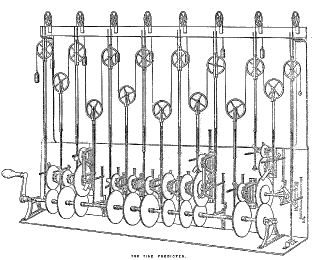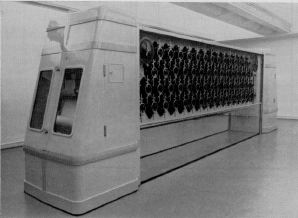

The Tide Predicter designed by William Thomson (later Lord Kelvin)in 1873, from the original paper of 1882. At the bottom, pairs of toothed disks (red and green in the sketch below) are driven by the operator, who turns the crank handle. Each pair of disks represent one tidal constituent (for example the lunar semi-diurnal constituent, which has a period of 12 hours and 25 minutes, solar semi-diurnal constituent with a period of exactly 12 hours etc.). The ratio of each pair determines the speed with which the upper disk turns, ie the period of the tidal constituent.
A rod carrying a wheel at its upper end is connected to a pin on the (green) disk and moves up and down with the disk's period. The pin's position on the disk determines the phase and amplitude of the tidal constituent. A steel band running around all wheels produces the sum of all constituents. Amplitude and phase have to be set for every port for which a prediction is to be made.

A sketch of the principle of the Kelvin tide calculator drawn 80 years after its invention, adapted from von Arx (1962). The principle was suggested by Beauchamp Tower during a shared train journey on the way to attend the British Association in 1872. Kelvin (1882) describes the birth of the idea himself:

The Kelvin tide predicter of the German Hydrographic Institute, built in 1938. It has a total length of 7.5 m and can handle 62 tidal constituents. To achieve the required accuracy thermal expansion of the parts was eliminated by keeping the machine in a temperature-controlled room. The machine was in use into the 1960s, when it was replaced by a digital computer. It is now in the Maritime Museum in Bremerhaven, Germany. Similar machine operated at the Tidal Institute in Liverpool, England (handling 42 constituents) and in the Coast and Geodetic Survey in Washington, USA (handling 37 constituents). From Dietrich (1957)
Dietrich, G. (1957) Allgemeine Meereskunde. Gebrüder Borntraeger, Berlin. English translation General Oceanography, an Introduction (1963) Interscience Publishers, New York.
Kelvin. (1911) The tidal gauge, tidal harmonic analyser, and tide predicter. In Mathematical and Physical Papers (Volume VI), pp 272-305 Cambridge. [From the Minutes of the Proceedings of the Institution of Civil Engineers, March 11, 1882.]
von Arx, W. (1962) An Introduction to Physical Oceanography.Addison-Wesley, Reading MA.